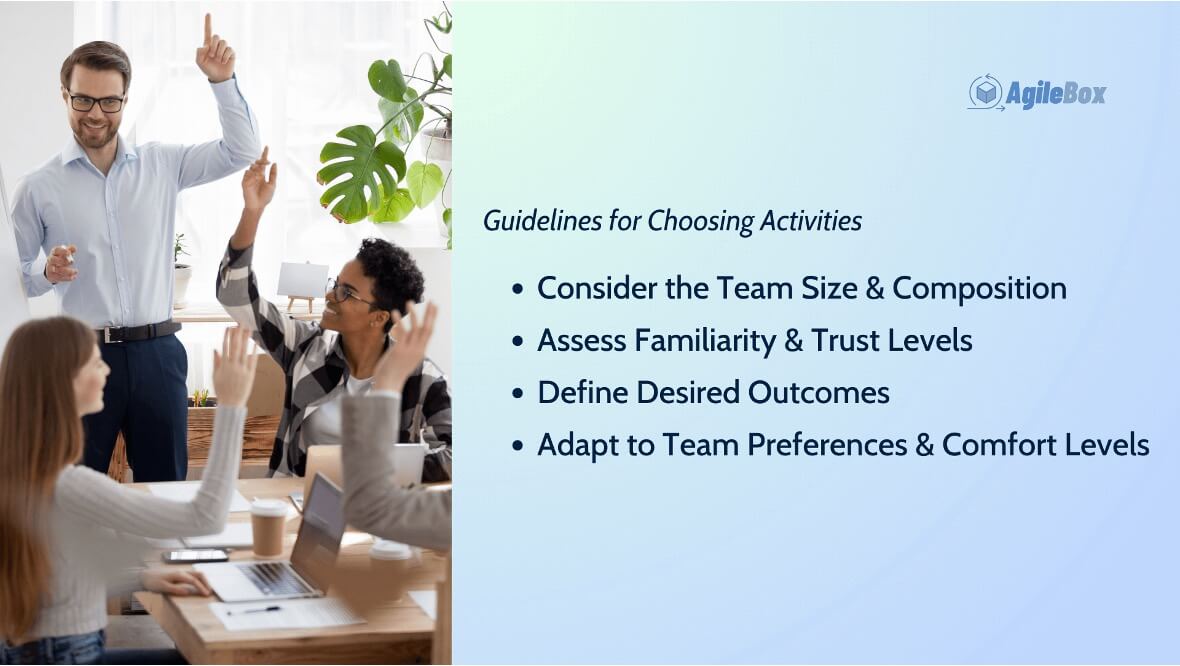I. The Purpose of Retrospective Ice Breakers
The primary purpose of incorporating icebreakers into retrospective meetings is to create a positive and inclusive atmosphere that encourages open communication, active participation, and team bonding. Icebreakers serve as catalysts to break down barriers and establish a foundation of trust and collaboration within the team. By engaging in these activities, team members can develop a deeper understanding of each other’s perspectives, strengths, and working styles.

Goals of Incorporating Ice Breakers into Retrospective Meetings:
- Create a comfortable and relaxed atmosphere. Icebreakers help set the tone for the retrospective by creating a safe space where team members feel comfortable sharing their thoughts and opinions.
- Encourage active participation. Icebreakers stimulate engagement and participation from all team members, ensuring that everyone’s voice is heard during the retrospective.
- Build rapport and trust. By fostering connections and interactions among team members, icebreakers facilitate the development of trust, which is crucial for effective collaboration.
- Enhance team communication. Icebreakers promote open and effective communication, allowing team members to better understand each other’s perspectives and ideas.
Benefits of Ice Breakers in Retrospective Meetings:
- Breaking down barriers. Icebreakers help break down social barriers, especially in newly formed or diverse teams, by creating opportunities for team members to interact and get to know each other beyond their roles.
- Fostering team bonding. Icebreakers build a sense of camaraderie and strengthen relationships among team members, improving collaboration and cooperation.
- Encouraging creativity and innovation. Icebreakers can spark creative thinking and innovative solutions by encouraging team members to think outside the box and share diverse perspectives.
- Increasing engagement and motivation. Engaging in icebreaker activities energizes participants and increases their motivation, resulting in higher levels of engagement during the retrospective discussions.
- Enhancing problem-solving and decision-making. Icebreakers stimulate teamwork and collaboration, enabling team members to collectively tackle challenges, solve problems, and make better decisions.
II. Choosing the Right Ice Breaker Activities
Icebreaker activities play a crucial role in setting the tone for a productive and engaging retrospective meeting. However, selecting the right icebreakers requires careful consideration to ensure they align with the team’s dynamics, goals, and comfort levels. Here are some guidelines for choosing the most suitable icebreaker activities for your retrospective meetings:

Consider the Team Size and Composition:
- Take into account the number of team members participating in the retrospective. Some icebreakers work best in small groups, while others are more suitable for larger teams.
- Consider the diversity within the team, including factors like age, cultural background, and personality types. Choose ice breakers that can accommodate and engage the entire team.
Assess Familiarity and Trust Levels:
- Evaluate the level of familiarity and trust within the team. If the team is new or comprised of members who have yet to work closely before, opt for icebreakers that focus on introductions and getting to know each other.
- For more established teams with higher levels of trust, consider icebreakers that delve deeper into personal experiences, challenges, or achievements.
Define Desired Outcomes:
- Clarify the objectives you want to achieve through the icebreaker activity. Are you looking to foster team bonding, encourage creativity, or address specific issues? Select ice breakers that align with these desired outcomes.
- If there are specific topics or themes you want to explore during the retrospective, choose icebreakers that help generate relevant discussions around those areas.
Adapt to Team Preferences and Comfort Levels:
- Take into account the preferences and comfort levels of the team members. Some individuals may be more extroverted and enjoy lively and energetic icebreakers, while others may prefer more introspective or low-key activities.
- Communicate with the team and gauge their comfort levels with different types of icebreakers. It’s important to create an environment where everyone feels safe and comfortable participating.
Remember, it’s important to adapt icebreaker activities to the specific needs and preferences of your team. Be open to experimenting with different icebreakers and adjust them as necessary to create an enjoyable and meaningful experience for everyone involved. By selecting the right icebreakers, you can set the stage for a productive and collaborative retrospective meeting.
III. Examples of Retrospective Ice Breakers
1. Two Truths and a Lie
Two Truths and a Lie is a popular icebreaker game that encourages team members to get to know each other better and builds a sense of camaraderie.
This game fosters a sense of connection and understanding among team members as they learn interesting facts about each other. It promotes active listening, communication, and a shared sense of discovery.
2. Appreciation Circle
The Appreciation Circle is an icebreaker activity that focuses on expressing appreciation within the team. It has a positive impact on team dynamics and morale.
The Appreciation Circle helps build trust, boosts team morale, and strengthens relationships within the team. It creates a culture of recognition and gratitude, making team members feel valued and appreciated for their contributions.
3. Team Building Games

Incorporating team-building games as retrospective icebreakers offers various benefits, such as promoting collaboration, problem-solving, and teamwork. Here are a few examples of simple and engaging games:
- Marshmallow Challenge. Provide teams with limited materials, such as spaghetti sticks, marshmallows, and tape. The objective is to build the tallest freestanding structure using only these materials. The game encourages creativity, communication, and collaboration.
- Lego Retrospective. Each team member builds a Lego model that represents their experience or insights from the previous sprint. Afterward, team members share the meaning behind their models, fostering discussion and reflection.
- Create a Playlist. You first need each person to create their playlist on Spotify or Apple Music. You can use this team-building icebreaker as an exercise for yourself, or you can use it in your next meeting. Engaging everyone in the process is the goal.
- Create a Dance. Dance is one of the easiest ways to bond with others in a fun, non-threatening way. You can teach employees how to do the Macarena or some other popular dance to show off their moves at the next company party.
These team-building games inject fun and excitement into the retrospective meeting, encouraging active participation and collaboration. They also provide a different perspective on team dynamics and problem-solving abilities.
4. Personal Highlights
Sharing personal highlights helps team members recognize their achievements, reinforces positive behaviors, and encourages a growth mindset. It also fosters a sense of pride and camaraderie within the team.
5. Photo Sharing
Photo sharing helps create personal connections, triggers memories, and deepens understanding within the team. It allows team members to see different perspectives, experiences, and achievements, fostering empathy and strengthening bonds.
IV. Tips for Successful Retrospective Ice Breakers
Tips for Successful Retrospective Ice Breakers:
- Manage time effectively to ensure the icebreaker fits within the overall meeting duration.
- Clearly explain the purpose and instructions of the icebreaker to the team.
- Actively facilitate the activity and encourage equal participation.
- Prompt and engage quieter team members to contribute.
- Foster a safe and inclusive environment for open sharing and respectful communication.
- Tailor icebreakers to the team’s dynamics, preferences, and comfort levels.
Fun Retro Icebreaker Questions:
- If you could have one superpower, what would it be?
- What movie series do you enjoy seeing repeatedly?
- Have you got a favorite comic or comedy show?
- Best trip you have ever been on?
- Favorite restaurant to eat in town?
- Which country would you love to travel to next?
These tips will help you incorporate ice breakers successfully, enhancing team engagement and creating a productive retrospective environment.
Conclusion
Retrospective icebreakers have the purpose of creating a positive and inclusive atmosphere, fostering team bonding, and promoting active participation. They break down barriers, build trust, and encourage open communication. When choosing icebreakers, consider team size, familiarity, and desired outcomes. Adapt activities to team preferences for a successful experience. Follow practical tips, manage time effectively, facilitate participation, and create a safe environment. Icebreakers enhance team dynamics and contribute to productive and engaging retrospective meetings.
After having the retrospective icebreakers, your team is now ready to start a retrospective meeting. AgileBox is here to help with various templates for the Agile Retrospectives feature. Check it out here: Agile Planning Poker, Retrospectives, Daily Standup for Jira.



